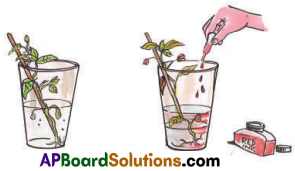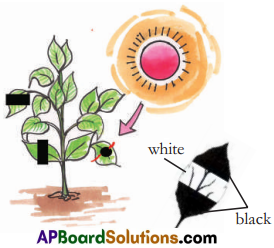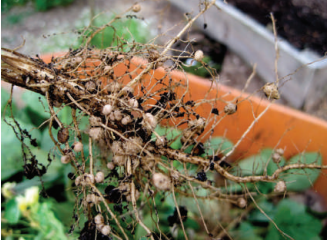These TS 7th Class Science Important Questions 10th Lesson Nutrition in Plants will help the students to improve their time and approach.
TS 7th Class Science Important Questions 10th Lesson Nutrition in Plants
Question 1.
What are stomata ? Write their importance.
Answer:
Definition : The leaves have tiny holes through which the exchange of air takes place. They are called stomata.
Importance of stomata:
- Stomata help in regulating gaseous exchange.
- They consume carbondioxide and release oxygen during photosynthesis.
- They also help in elimination of excess water from the plant by the process called transpiration.
![]()
Question 2.
What is herbarium?
Answer:
Preserving rarely available plant parts or whole plant in an artistic way is known as herbarium.
Question 3.
What is photosynthesis and autotrophs?
Answer:
- Green plants use carbondioxide in the presence of sunlight along with water to make glucose (or) starch and other food material.
- This process of making food material is called as photosynthesis and such plants are called autotrophs.
Question 4.
Explain symbiotic relationship in lichens.
Answer:
- There are colonies of algae and fungi living together in a symbiotic relationship. These colonies are known as lichens.
- This relationship starts with the attack of algal colony by a type of fungus.
- Later, as algae survive, they are given protection from intense light and conditions of drying up due to the presence of fungus colony. The fungus gets food from its partner.
Question 5.
Write the chemical equation you studied about photosynthesis.
Answer:

Question 6.
How gaseous exchange takes place in plants ? (or) What are stomata?
Answer:
Plants use carbon dioxide and release oxygen by the process of photosynthesis. The exchange of gases is done by the leaves. Leaves have tiny holes through which the exchange of air takes place. These holes are called stomata.
![]()
Question 7.
Kiran had doubts on nutrition in plants. He wanted to clarify them at his science teacher. If you were in the place of Kiran, what questions would you ask?
Answer:
- Why nutrition in plants is vital character?
- How plants obtain their food?
- What are the factors that help all the plants to maintain nutrition?
- Do plants prepare food on their own?
Question 8.
If stomata are absent in plants, what consequences occur in the plants?
Answer:
Stomata facilitate exchange of oxygen and carbondioxide in the plants. If it is absent, the plants cannot prepare food. They will lose food synthesizing capacity. Also, stomata have the capacity of eliminating excess of water from the plants. Plants cannot transpire without stomata. Hence, plants cannot survive witout stomata.
Question 9.
On the basis of given experiment that is revealed through the diagram, what conclusion you draw about the function of root and stem in the nutrition of plants?

Answer:
- The roots of plants absorb water and minerals from the soil and supply to main trunk of the plant.
- From trunk, water and minerals are supplied to every part of the plant.
- More occurrence of water and minerals are essential in case of more nutritious activities.
![]()
Question 10.
Write the information you collected from the farmers and farming field about absorption of water and minerals by root and stem to enhance nutrition of plants?
Answer:
- Farmers sprinkle urea in growing crop fields. Urea is mixed with water and further absorbed by roots.
- Farmers irrigate the field after sprinkling urea in the field, because urea mixes with the water which is further easily absorbed by roots. From roots, urea containing water goes to all parts of the plants through the stem for nutrition.
Question 11.
Write the examples of some insectivorous plants that you saw.
Answer:
Droseras, Utricularia, Venusflytrap etc. are examples of insectivorous plants.
Question 12.
Draw the diagram of stomata. Write their function.

Answer:
Stomata are present on the surface of leaf. They help in exchange of gases and elimination of water that enter the plants.
Question 13.
Though some organisms are considered plants they behave like heterotrophs. Justify the answer.
Answer:
- Plants such as cuscuta is a parasitic plant. It has haustoria a root like structure absorb nutrients from host plant.
- Fungi are saprophytes which absorb organic matter from dead and decaying matter.
- Plants such venusulytrap, utricularia, drosera grow in nitrogen deficient areas. Hence they obtain nitrogen by trapping insects.
Choose the correct answer:
I. Conceptual Understanding
Question 1
described the leaves as organs of transpiration. ( )
A) Priestly
B) Ingenhouz
C) Hales
D) Hill
Answer:
A) Priestly
![]()
Question 2.
Who found that only the green parts of plants could do the purification of air in the sunlight. ( )
A) Ingenhouz
B) Hales
C) Lavoiser
D) Robert hill
Answer:
A) Ingenhouz
Question 3.
In plants, exchange of gases takes place through ( )
A) stem
B) leaves
C) roots
D) stomata
Answer:
D) stomata
Question 4.
This is the important factor for photosynthesis in the plants. ( )
A) Minerals
B) Sunlight
C) Chemicals
D) Nitrogen gas
Answer:
B) Sunlight
Question 5.
The main nutrients required for the plants. ( )
A) Nitrogen
B) Potassium
C) Phosphorous
D) Options A, B and C
Answer:
D) Options A, B and C
![]()
Question 6.
Example of parasitic plant. ( )
A) Cuscuta
B) Lichen
C) Beans
D) Groundnut
Answer:
A) Cuscuta
Question 7.
Cuscuta (parasitic plant) develops special roots called ( )
A) hooks
B) dodder
C) haustoria
D) parthenia
Answer:
C) haustoria
Question 8.
Plants that grow on dead and decaying matter. ( )
A) Algae
B) Fungi
C) Venustlytrap
D) Amoeba
Answer:
B) Fungi
II. Asking Questions and Making Hypothesis
Question 9.
Find out the odd one regarding carnivorous plants. ( )
A) Mushroom
B) Droseras
C) Venusflytrap
D) Utricularia
Answer:
A) Mushroom
Question 10.
One of the following sentences is not correct. Find out. ( )
A) Cuscuta is a parasitic plant
B) Plants of Dal family are carnivorous
C) Plants take sunlight
D) Roots help in absorbing minerals and water
Answer:
B) Plants of Dal family are carnivorous
![]()
Question 11.
If stomata are closed in plants ( )
A) plants consume food through stem
B) plants go for alternative method of gaseous exchange
C) plants take rest until opening of stomata
D) plants cannot perform photosynthesis and ultimately die.
Answer:
D) plants cannot perform photosynthesis and ultimately die.
III. Experimentation and Field Investigation
Question 12.
What was explained through experiment of black paper on the leaf of plant. ( )
A) Water is essential for photosynthesis
B) Sunlight is essential for photosynthesis
C) Carbondioxide is essential for photosynthesis
D) Minerals are required for food preparation
Answer:
B) Sunlight is essential for photosynthesis
Question 13.
What are the plants you found that grow on other plants with yellow thread like structures twining around the stem. ( )
A) Cuscuta
B) Utricularia
C) Mushroom
D) Bitter gourd
Answer:
A) Cuscuta
![]()
Question 14.
What will we see on the dead decaying matter in the rainy season.
A) Parasitic plants like dodder ( )
B) Insertivorous plants like Venusflytrap
C) Fungi such as mushroom
D) Synbiotic nutrient plants.
Answer:
C) Fungi such as mushroom
IV. Information Skills and Project
Question 15.
Read the following para and answer the question. ( )
A few plants manufacture their own food but also obtain a part of their nutrition from insects. Leaves of these plants are specially modified to trap insects.
Q. What plant species are explained through above passage? ( )
A) Insectivorous plants
B) Carnivorous plants
C) Mushroom
D) A or B
Answer:
D) A or B
Question 16.
The farmer sprinkles the following product in order to reduce the yellow colouration of leaves. ( )
A) Urea
B) Nitrogen
C) Zinc
D) Copper
Answer:
A) Urea
Question 17.
Insectivorous plants grow in area deficient in ( )
A) zinc
B) copper
C) nitrogen
D) hydrogen
Answer:
C) nitrogen
V. Communication through Drawing and Model Making
Question 18.
Given diagram explains. ( )

A) water is important for photosynthesis
B) light is important for photosynthesis
C) minerals are important for photosynthesis
D) All the above
Answer:
B) light is important for photosynthesis
![]()
Question 19.
The given picture of roots with nodules are seen in ( )

A) Cuscuta
B) Utricularia family
C) Maize family
D) Dal family
Answer:
D) Dal family
VI. Application to Daily Life and Concern to Bio Diversity
Question 20.
Plants consume insects to obtain is an amazing activity. ( )
A) nitrogen
B) phosphorous
C) potassium
D) iron
Answer:
A) nitrogen
Question 21.
Even in the absence of chlorophyll, these plants absorb organic substances from dead and decaying matter. ( )
A) Parasites
B) Saprophytes
C) Carnivores
D) Herbivores
Answer:
B) Saprophytes